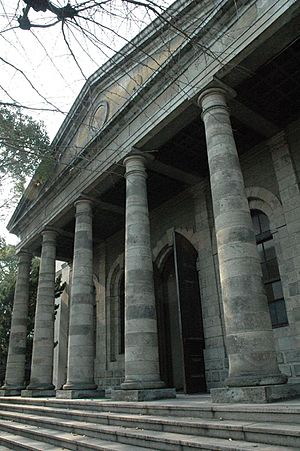Thomas Waters facts for kids
Quick facts for kids
Thomas James Waters
|
|
|---|---|
| Born | 17 July 1842 Birr, County Offaly, Ireland
|
| Died | 5 February 1898 (aged 55) Denver, Colorado, United States
|
| Nationality | Irish |
| Occupation | Architect |
Thomas James Waters (born July 17, 1842 – died February 5, 1898) was an Irish civil engineer and architect. He played an important role in Japan during a time of big changes, known as the Bakumatsu and early Meiji period. He helped design many modern buildings.
Contents
Thomas Waters: Building Japan's Future
Early Life and First Projects
Thomas Waters was born in 1842 in Birr, a town in Ireland. He was the oldest son of a local surgeon. When he was in his early 20s, around 1864, he worked on building the Royal Mint in Hong Kong.
Through his uncle, Albert Robinson, Thomas Waters met people connected to Thomas Blake Glover. Glover was a well-known British merchant living in Nagasaki, Japan. Glover helped Waters get a job with the Satsuma Domain. This was a powerful area in Japan at the time.
Waters was hired to build sugar mills that used steam power on the island of Amami-Oshima. After this, he moved to Kagoshima in 1867. There, he started designing buildings in a Western style.
Helping Japan Modernize
After the Meiji Restoration in 1868, Japan's government changed. The new Meiji government hired Thomas Waters. They asked him to build the new Imperial Japanese Mint in Osaka. He started this big project in 1868, and it was finished by 1870.
Because he did such a great job with the Mint, Waters was invited to Tokyo. The government officially hired him as a "foreign advisor," which in Japanese was called an oyatoi gaikokujin. His title was "Surveyor-General."
In Tokyo, he helped design a branch of the Japanese Mint in the Ginza area. He also designed and built the main building for the Imperial Japanese Army. He even built a bridge on the grounds of the Tokyo Imperial Palace.
Rebuilding Ginza: Tokyo's Bricktown
Thomas Waters' biggest project came after a terrible fire in 1872. This fire destroyed a large part of the Ginza district in Tokyo. Waters, along with his brother Albert Waters and an English friend named A. N. Shillingford, led the effort to rebuild Ginza.
They created a wide main street lined with many brick buildings. These buildings were one or two stories tall and designed in the Georgian style, which was popular in the West. This rebuilt area became known as Bricktown (Rengagai). It quickly became a symbol of how modern and Western Japan was becoming.
Later Years and Legacy
As time went on, Thomas Waters faced more competition. Other foreign architects and newly trained Japanese architects and engineers were also working in Japan. He decided to leave Japan around 1878.
After leaving Japan, he worked for a short time in Shanghai, China. Then, he became a mining engineer on the South Island of New Zealand. Later, he joined his brothers, Ernest and Albert, in the United States. There, they worked in silver and gold mining in Colorado.
Thomas Waters passed away on February 5, 1898, when he was 55 years old. He is buried at Fairmount Cemetery in Denver, Colorado.


